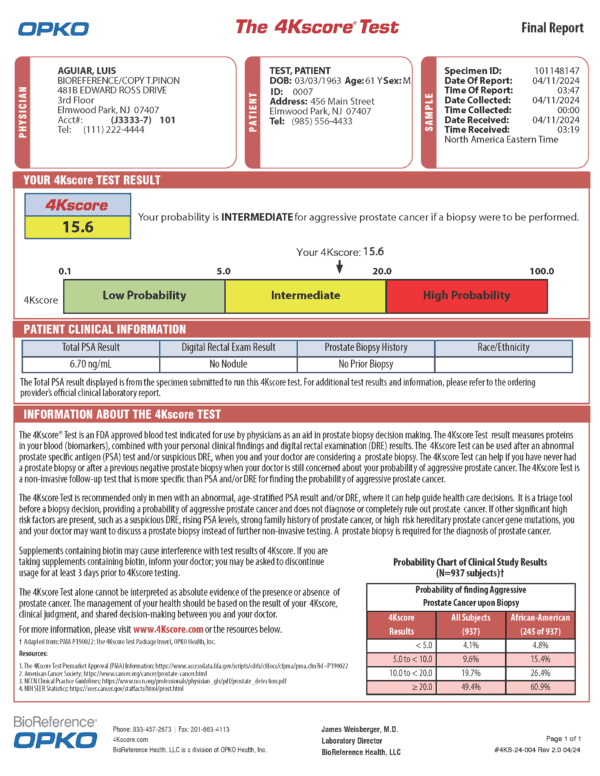What do my 4Kscore results mean?
The 4Kscore was developed to aid physicians in determining if their patient with an abnormal prostate specific antigen (PSA) blood test or prostate exam may require a prostate biopsy.
The 4Kscore is a non-invasive follow-up test that is more specific than PSA and/or DRE for finding the probability of aggressive prostate cancer. It can be used after an abnormal prostate specific antigen (PSA) test and/or suspicious DRE, when you and your doctor are considering a prostate biopsy.
The 4Kscore provides a percent risk of a patient having aggressive prostate cancer on biopsy, and determines the probability of finding high-grade, aggressive prostate cancer if a prostate biopsy were to be performed.

This test has been shown to be far more accurate than PSA in determining if a patient may have aggressive prostate cancer. Unlike PSA, the 4Kscore is not influenced by benign prostate conditions, such as infection or an enlarged prostate.
Interpreting your report
Your 4Kscore Test Result
This section discusses the risk findings of your 4Kscore. Your report may indicate a different risk interpretation such as, “low probability”, “intermediate”, or “high probability”. <5 is classified as low risk, <20 is classified as intermediate, and 20-100 is classified as high risk. In this example, the report indicates an intermediate risk at 15.6, suggesting that the patient would not need a biopsy.
The test also may predict the probability that a patient will develop distant metastases in the next ten years. For example, a percentage shown as 99.8%, suggests that this particular individual has a 99.8% chance (out of 100%) that he will NOT have prostate cancer that has spread outside of the prostate to areas beyond the pelvis. The higher this number, the lower the risk of distant metastases.
Patient Clinical Information
This section describes your individual clinical information, which includes the results of your digital rectal examination (DRE), and your prostate biopsy status.
Information About the 4kscore Test
This section describes how the 4Kscore was validated, the biomarkers used in the 4Kscore algorithm, and how you and your health care provider should use the result to decide if a biopsy should be performed.
The 4Kscore was designed to determine a patient’s risk of having a Gleason Score 7 or higher prostate cancer should they receive either an initial or a repeat biopsy. The score is computed using several different factors, such as Total PSA, Free PSA, Intact PSA, Human Kallikrein-2 (hK2, an enzyme that is prostate specific and can break bonds in proteins), as well as the patients age, prostate exam findings, and prostate biopsy history. All these factors go into a special mathematical equation that results in your final score.
According to the research behind the test, if your 4Kscore is greater than 20, you may need a prostate biopsy. However, the decision to undergo a biopsy should be individualized and considered after a thorough discussion with your health care provider.
